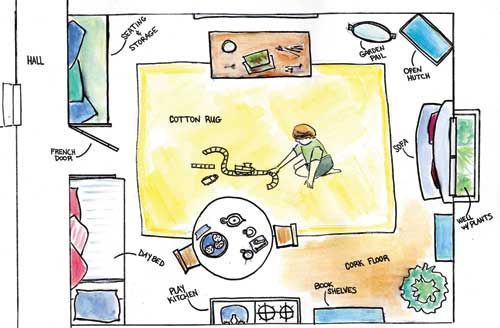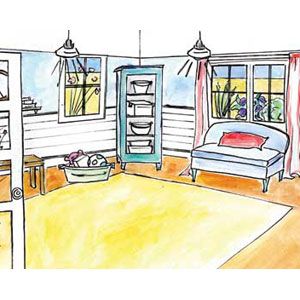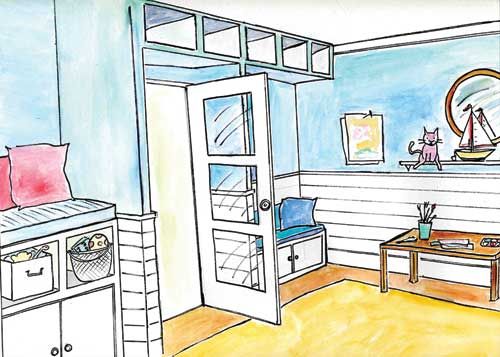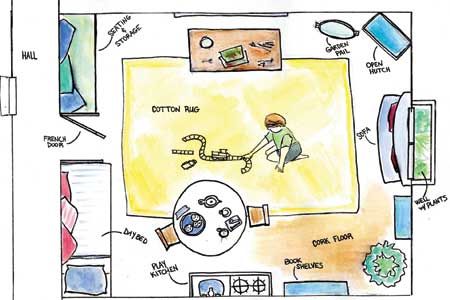
As the mother of a 4-year-old, and a fairly avid environmentalist, I know firsthand that “green” design can contribute to a beautiful playroom that you and your children will enjoy. All you need are some readily available, sustainable materials and some outside-the-box thinking. Here’s how I would approach it.
1. Materials
The key to a successful playroom is to make it a place adults will also want to spend time in. That means not skimping on the design elements: architectural details, interesting colors and furnishings, and comfortable fabrics. Besides, children are often far more visually sophisticated and aesthetically sensitive than we give them credit for.
A playroom is one of the best places to use natural materials because in addition to being earth-friendly, they’re also people-friendly. All-cotton fabrics and rugs resist mildew and clean up easily, which means they are healthier for children, who are more susceptible to allergic reactions from chemicals, mold, dust, and dander. Plus, many natural materials hold up better than their synthetic counterparts.
On the floor, consider cork, which is hypoallergenic, has a low-static surface so it resists collecting dust and pet hair, and can withstand moisture. It comes in easy-to-install planks or tiles and is as easy to maintain as hardwood. Cork is also soft underfoot, which makes crawling around more comfortable for kids. For the walls, you can now get low-VOC, water-based paints in a rainbow of colors from major brands like Benjamin Moore.

2. Design and Furnishings
While you want a room with furnishings scaled for kids, that doesn’t mean your playroom has to be a plastic palace. For instance, you can make a nice wooden kid-height table for finger painting or game playing by simply chopping a few inches off the legs of a full-size table. Likewise, wood garden benches can be cut down a few inches—just enough for little ones to be able to hoist themselves up, but not so low as to make sitting difficult for adults—and covered with comfy cushions.
Salvaged materials are obviously green, but they also give a room personality. Dress up windows with wood trim from an architectural salvage warehouse, finished in natural shellac and a coating of beeswax, which are nontoxic and won’t off-gas. Distressed painted furniture looks both fun and elegant; just be sure to seal it with water-based, clear topcoats so paint doesn’t chip off and into little mouths. Speaking of paint, to give the room a more airy feel, consider shades inspired by nature—water, sky, stone, or sand—instead of the ubiquitous primary colors.
Chances are your children are going to have heaps of toys that will need to have a home when not in use. Baskets, enamel bins, and garden containers set into armoires with the doors taken off make for beautiful, practical storage for toys and craft materials. Built-in seating and toy bins also clear up more floor space for playing and give kids another thing to crawl on and around.

3. Considerations for a Basement
Since you’re planning a basement playroom, you’ll need to pay special attention to such things as lighting and ceiling height, so kids don’t feel like they’ve been banished to the dungeon. I like to install tin ceiling tiles directly onto joists to get maximum headroom. On the walls I prefer plaster, which isn’t affected by moisture. If you frame up new walls, use paperless wallboard instead of the conventional kind, which can be a mildew magnet.
When it comes to lighting, take full advantage of whatever natural light you have and combine it with out-of-the-way fixtures like recessed can or track lighting. Larger, functioning windows are key to making a basement space feel inviting. To avoid a drab view, adorn window wells with potted plants or built-in planting beds. And if you make the entrance to the room a French door, you’ll get more light—plus you’ll be able to see your children enjoying their new space.

